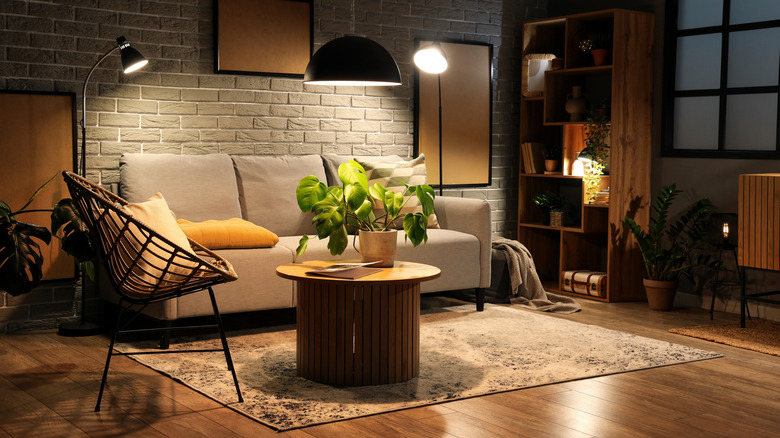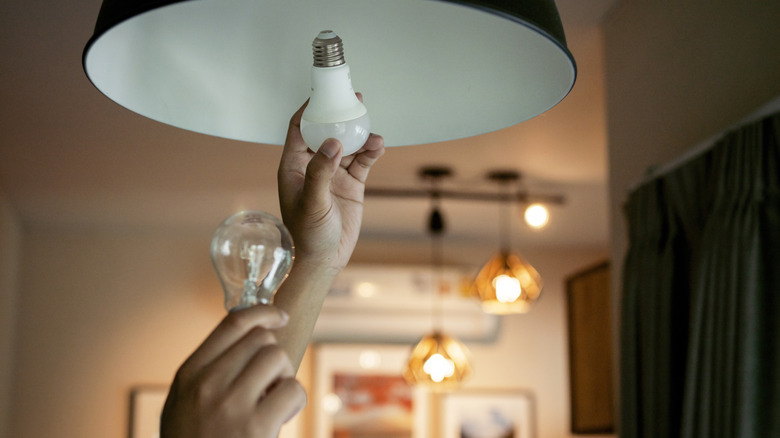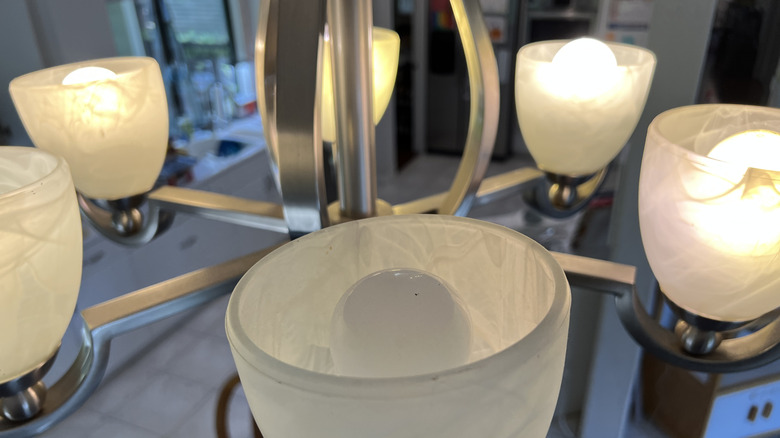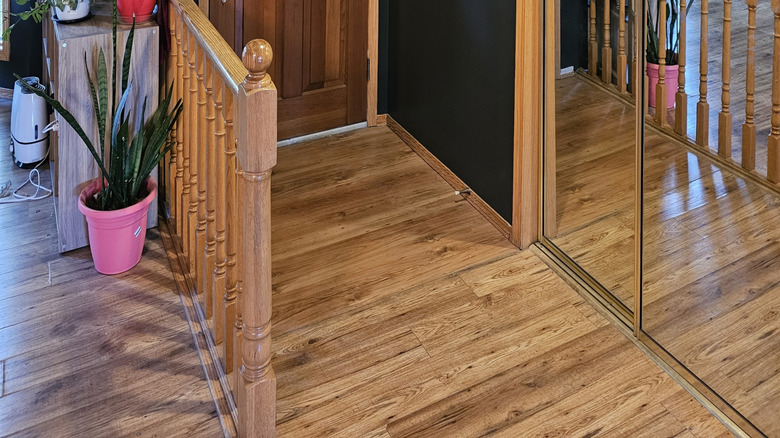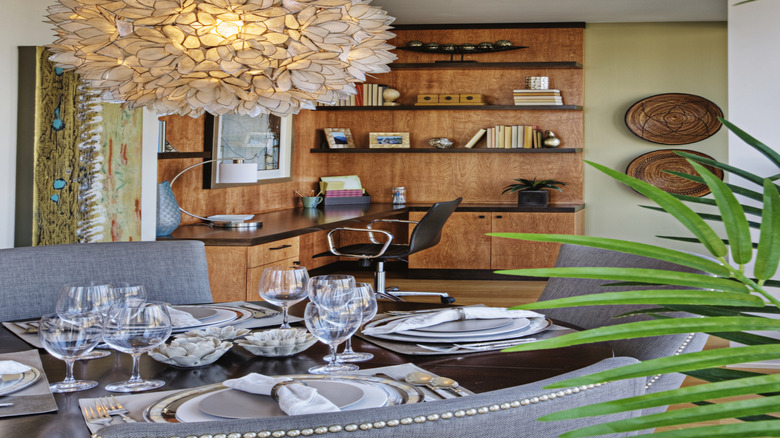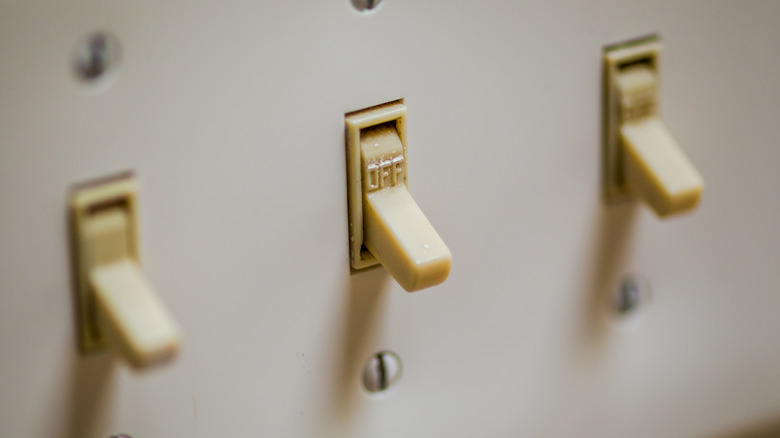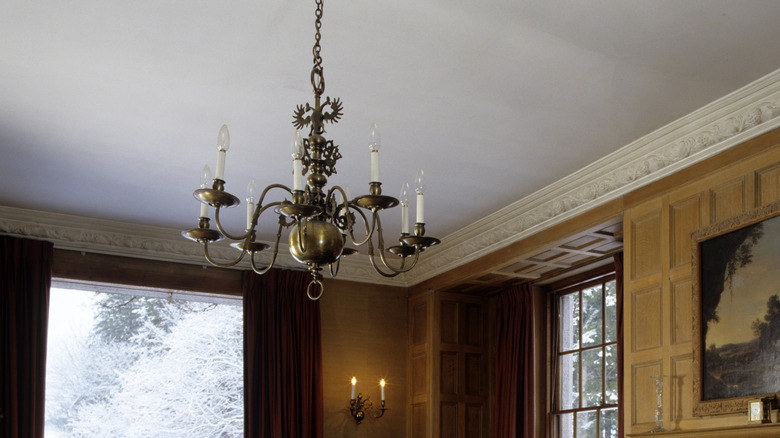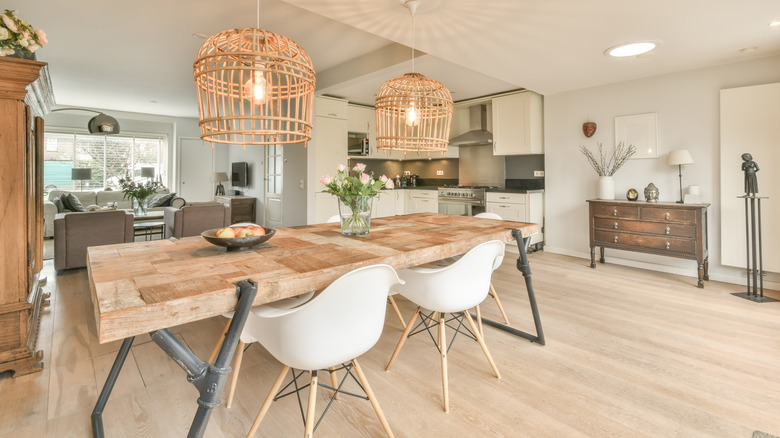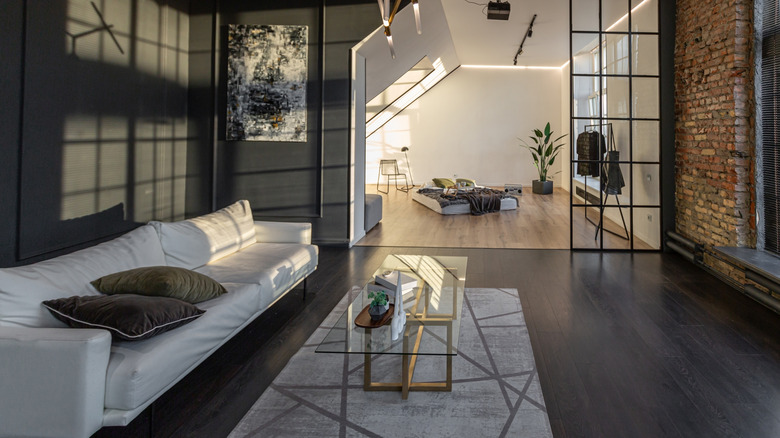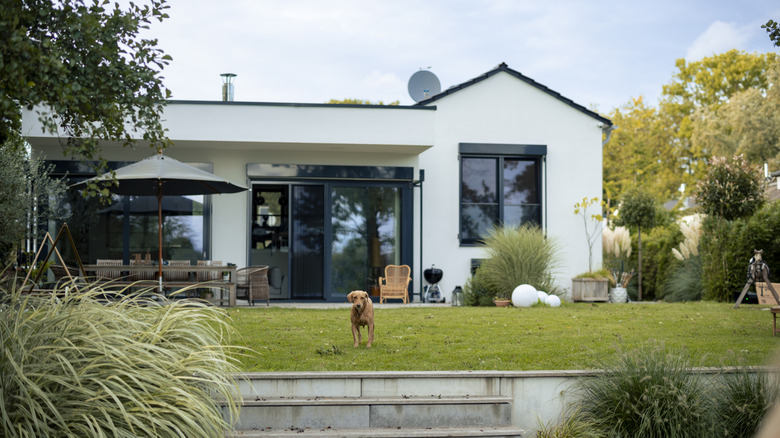Lighting Mistakes To Avoid When Selling Your Home (And What To Do Instead)
When you're gearing up to put your house on the market, there is a lot you need to do to make it buyer-ready. From packing away overly personal items to toning down loud paint colors to selling off some of your furniture so the rooms don't seem too crowded, there is a lot to keep track of. However, one thing most sellers forget to zero-in on is their lighting. There are tons of lighting mistakes you can accidentally make that will be a potential turnoff to interested buyers, making them want to bid under-asking at best and walk away from the listing entirely at worst.
These mistakes span from small faux pas to more obvious errors. From having varying color temperatures in a single room to leaving burnt-out bulbs in chandeliers or recessed lights, they're details that most buyers will clock and cause them to alter their impression of your home. "One of the main things that I tell my clients before listing a home is how important a role lighting plays," Michael McGuirk, a licensed real estate agent in New York and Connecticut with Sotheby's International Realty, exclusively tells House Digest." It is crucial not only for when people are touring, but also for setting the scene in the photographs. Your home needs to feel inviting and attractive and the proper use of lighting will help to achieve that." If you want to ensure your house is in the best shape it can be before it goes on the market, make sure you're not accidentally making these lighting mistakes.
Having mismatched bulbs can make your house seem disjointed
If you're not particularly aware of light bulb color temperature, you might not care which bulb you pop into a fixture when it burns out. Because of this, a single room can have mismatched cool and warm lighting, but that's a mistake if you want to attract buyers — especially those who come to a showing in the evening after work. "Different colors, hues, and intensities can create a disjointed look," warns McGuirk. "It is amazing how many times I have seen two of the same lamps in a room and each has a bulb with a different color temperature."
It's a seemingly small detail, but it can make the space feel messy at best and potentially low-end at worst. And if you want to capture clients who are willing to pay over-asking, that's not the scene you want to set. Instead, ensure all of the lighting matches across the room so the space feels more cohesive. "Consistent colors throughout (I like to use warm) create a more cohesive and polished appearance," McGuirk explains. Bulb color temperatures range from 1,000k (the warmest) to 10,000k (the coolest). The warmer end of the spectrum has more orangeish and yellowish tones, which feel cozier and more inviting. The cooler end is blueish in tone, which is great for task lighting but can feel too harsh or sterile as ambient lighting. To choose a light bulb color, zero in on the tone you want to set in that particular room. For spaces earmarked for relaxation, like bedrooms and dens, consider getting soft white or warm white lights, which range from 1,000K to 6,000K. Such an example is Amazon Basics' Soft White LED Light Bulbs. For more utilitarian spaces, like kitchens or offices, get daylight, which is smack-dab in the middle of the range at 5,000k to 6,500k and is more blue-tinged. An example is Vation Lighting's Daylight LED Bulbs. However, you want to avoid bright white or cool white, which has 7,000k to 10,000k, as that's earmarked for spaces like utility closets and garages.
Overlooking burnt-out or missing bulbs can make your home look neglected
As you prepare to move out, you might not be too concerned with small details like a burnt-out bulb in the linen closet or missing lights in the basement. With your move likely just a few months away, buying a box of bulbs might seem like a waste. However, neglecting to replace those missing lights can create a potential turnoff to buyers — especially those who are on the fence over your listing. "When there are bulbs missing from fixtures, and this usually happens with canned ceiling lights, the buyer might think that there is an issue with the electricity. But it also goes beyond that, because it might make a space feel neglected," McGuirk cautions. This can be enough to make a buyer walk and move on to the next listing.
Instead, put "double-checking each light fixture" on your moving checklist before opening your doors to any showings. "Checking and replacing all bulbs before listing a home sets the tone for a well cared for house," McGuirk explains. While you will want to check all ambient lighting like pendants, chandeliers, recessed cans, and fan lights, you will also want to double-check more utilitarian lighting, like bulbs in the garage, basement, closets, shed, and backyard patio. Ensuring everything turns on when you want it to will eliminate one more concern for potential buyers.
Leaving your foyer dark and dingy can set the tone for the rest of the house
If you have an older home or an entryway without windows, your foyer might feel darker compared to the bright, open spaces found in most modern homes. However, leaving it this way can be a major mistake. "The mood in the entryway and foyer is so important in setting the tone for what the buyer is in store for when they walk into your home. A dark entrance feels uninviting," McGuirk says. Walking into a dim space makes it seem like the rest of the house might be a fixer-upper that needs some brightening, bracing the viewers for the worst.
Instead, invest in brightening up the space. "Ensuring that the foyer is well-lit with an attractive overhead fixture, maybe even a statement piece, is a great first step, but taking it further with a table lamp or wall sconces can help to create depth and warmth and make it feel welcoming," McGuirk explains. "Like I tell my clients, first impressions go a long way."
Begin by ensuring you have ample ambient lighting. Update any dreaded flush mount lights with something larger and brighter, preferably with multiple bulbs. For example, Article's Coy Flushmount Ceiling Light has four bulbs, providing plenty of light without overwhelming the small space. At just 9 inches long, it works well even on lower ceilings. To increase brightness, also consider getting sconces on the walls. If you don't want to pay for an electrician, you can get wall-mounted versions with remote-controlled and battery-operated puck lights, such as NIORSUN Battery Operated Wall Sconces. Lastly, round out the design with a small table lamp on your entryway table, which you can switch on right before buyers come. And while you might think cool light bulbs will make the space feel brighter, the opposite is actually true. Blue light can make a dim space feel even dingier, so opt for warm bulbs that will make the foyer feel cozy and inviting.
Installing (or leaving) overly ornate or trendy fixtures can alienate buyers
You might be tempted to place a statement piece in the dining room or buy something Instagram-worthy for the entryway to attract buyers, but that can backfire more than it can help. "There is a delicate balance between statement lighting fixtures in homes that are for sale," McGuirk explains. "I always tell my clients that they need to look at their home through buyers' eyes." Is your home easy enough for a buyer to picture living in? If it has niche lighting fixtures that are way outside of their comfort zone, it might be difficult for them to imagine making it their own. However, McGuirk notes that this isn't a hard and fast rule.
"Of course, this does not mean that it cannot help in the home's appeal. If it is the right statement piece, it can help define a particular space, highlight architectural features, add character to help the buyer connect to the home, and even create a high end look by adding a sense of luxury." The key is to choose a fixture that's simple enough to appeal to a broad range of buyers, alienating as few of them as possible. Anything else — especially if the fixture costs upwards of $1,000 as most trendy pieces tend to — and you'll see very little ROI for your efforts. And there is nothing worse than spending money on an improvement only to have the new owner toss it the moment they move in.
Another alternative is to swap out the central light fixture altogether in favor of recessed lighting. "They thoroughly light rooms and don't stick out in a buyers' minds when they are shown the home," Robert Washington, a broker at Savvy Buyers Realty, exclusively tells House Digest. This might make sense to do in places like foyers, hallways, home offices, or flex rooms.
Keeping your old light switches can lower the overall impression of your home
Another common mistake most sellers make is forgetting to update their old light switches. If you have outdated plates that have since yellowed or cracked with time, it can lower the overall impression of your home. "I've been in too many homes with beautifully updated lighting and 30 year old light switches," Washington notes. "It may be a pet peeve of mine, but it is such an inexpensive item to update and I feel like it is too often forgotten about." Not doing so can make your home appear unkempt, which may lead some buyers to wonder what else has been neglected or unmaintained over the years.
Luckily, the fix is simple. "Sellers should consider replacing the light switches with modern switches and dimmers," Washington advises. If you would rather not cut too deeply into your profits, you can get something inexpensive, like the Decora 15 Amp Single-Pole Switch, which retails for $2.47 per switch. Dimmer switches, however, cost a little more. The Decora version is $3.96, but is still a budget-friendly home upgrade you can make before putting your listing on the market.
Keeping dated light fixtures can make your home seem unmaintained
Similarly, if old-fashioned light switches are going to turn off a portion of the buyer pool, dated light fixtures will make an even worse first impression. Having flush mount ceiling lights, frosted and since-yellowed sconces, and large clunky can lights can make your rooms feel a lot more neglected than they actually are. They will also make slightly dated features feel a lot older than they have to. For instance, yellow oak kitchen cabinets, baseboards, and window trims are slowly coming back into style, but they feel a lot more modern and intentional if paired with modern sconces, such as CB2's Astr White Onyx Wall Sconce. It might cost an arm and a leg to update wooden cabinets or get completely new trim, but it will cost significantly less to swap out those out-of-style fixtures.
"Swapping these for modern, cohesive designs is one of the fastest, most affordable upgrades," Alexei Morgado, realtor and CEO of Lexawise Real Estate Exam Preparation, exclusively tells House Digest. To do so, look for stylish but unobtrusive designs. You want to appeal to as many buyers as possible, so try to pick fixtures that feel design-conscious but appeal to various tastes. For instance, something like WOKNOS Mid-Century Modern Gold Semi Flush Mount Ceiling Light can match everything from contemporary to transitional to mid-century designs, whereas Yosoan Brass Sconces can fit traditional, boho, vintage, or modern designs. The more versatile it is, the less alienating it will be.
Using light fixtures that aren't proportional adds another item buyers need to change
Another potential turnoff is leaving light fixtures that are either too big or too small for the space. Maybe you bought a chandelier years ago that turned out to be too big for the dining room, or you purchased wall sconces without double-checking the measurements, only to find they were too small for the living room with its high ceilings. If returning or exchanging them was a hassle, you might have kept them and learned to live with it. While your eye adapted to the design faux pas, potential buyers might find it irksome and add it to the "yet another thing I have to change" list when they move in. This could turn quite a few people away.
"Fixtures that are too large or too small disrupt a room's balance; choose sizes that are in proportion to the space," Morgado recommends. There are some basic design rules that can help you narrow down the right sizes. First, if you have ceilings that are 8 feet or less, you want to stick to flush or semi-flush mount lights to make your ceiling appear higher. While a pendant or chandelier might be more interesting design-wise, it can also make the room feel smaller. An example is the Lakumu Globe Semi Flush Mount Ceiling Light, which is a brass orb fixture. However, if the space is wide, choose a semi-flush mount fixture that is also broad so it doesn't feel too small for the room. On the other hand, if the fixture is hanging over a piece of furniture, such as a table or a bed, take its width and subtract 12 inches. That will be the width of the appropriate light fixture.
Not doing everything you can to increase natural light
While you might be swapping out fixtures or old light bulbs to brighten dim rooms, one thing that can't be overlooked is doing everything you can to improve the natural lighting in the house. That way, you won't have to rely as much on fixtures when having showings or open houses during the day. In addition, homes with ample natural light tend to sell faster and have a higher resale value. In fact, according to Lutron Electronics 2023 Lighting Trend Report, 74% of surveyed buyers wouldn't buy a home with poor, dingy lighting, even if it had other features that they really liked.
Because of this, do a walk-through of your home and see how you can make the rooms brighter. "Getting your windows cleaned can work wonders by opening up your home. Couple that with making sure all the blinds and curtains are open and you have an easy way to maximize brightness," McGuirk recommends. "Most homes are shown during daylight hours so taking advantage of natural light creates a feeling of a home being able to breathe." Another smart way to brighten a dark room is to remove heavy window treatments, like thick curtains, valances, or cornices. This is especially beneficial in east- and north-facing rooms, which get little light in the afternoon. Instead, swap them out for sheer curtains, which will still offer privacy but allow much more light.
Forgetting outdoor lighting lowers your curb appeal
While you might be preoccupied with getting your lighting in order inside your house, it would be a mistake to forget the outside of your house. "Outdoor lighting shouldn't be forgotten. Pathway and porch fixtures provide safety and more curb appeal, showcasing your home's features for a more interesting presentation to prospective buyers," Morgado notes. Not only will this make your home look more appealing, but it can also boost resale value. According to a 2023 National Association of Realtors report, improving landscape lighting has a 59% ROI, showing that it's important to a wide pool of buyers.
To improve lighting, first ensure your front door and house number are illuminated. You can do this by either adding a fixture directly over your door or adding sconces on either side of it. Some examples include the Illumishin Outdoor Wall Light Sconce above a single door or the 17 Stories Lantern Sconce if you have double doors. To illuminate the exterior of the house, use uplighting, with floodlights pointed up to highlight certain parts of the house. You mainly want to put these over any architectural features you want to highlight, such as pillars, arches, dormers, or accent walls. Lastly, don't forget to illuminate your pathway and driveway, and you can do so using stake or post lights. Place them every 10 feet to ensure you don't overcrowd the landscaping, and choose a style that would best fit your home's aesthetic. For instance, if you have an American Craftsman house, consider getting a lantern with similar strong, boxy lines, such as Thomas Lighting Post Lantern.
